Magnetic Properties of CuCr1−xLaxS2 Thermoelectric Materials
Abstract
1. Introduction
2. Experimental
3. Results and Discussion
4. Conclusions
Author Contributions
Funding
Institutional Review Board Statement
Informed Consent Statement
Data Availability Statement
Acknowledgments
Conflicts of Interest
References
- Korotaev, E.V.; Syrokvashin, M.M.; Filatova, I.Y.; Sotnikov, A.V.; Kalinkin, A.V. The Charge Distribution, Seebeck Coefficient, and Carrier Concentration of CuCr0.99Ln0.01S2 (Ln = Dy–Lu). Materials 2023, 16, 2431. [Google Scholar] [CrossRef]
- Okada, T. Intercalation of Organic Compounds into Layered Clay Minerals. Oleoscience 2014, 14, 189–196. [Google Scholar] [CrossRef]
- Constantino, V.R.L.; Barbosa, C.A.S.; Bizeto, M.A.; Dias, P.M. Intercalation Compounds Involving Inorganic Layered Structures. An. Acad. Bras. Cienc. 2000, 72, 45–49. [Google Scholar] [CrossRef]
- Ushakov, A.V.; Kukusta, D.A.; Yaresko, A.N.; Khomskii, D.I. Magnetism of Layered Chromium Sulfides MCrS2 (M = Li, Na, K, Ag, and Au): A First-Principles Study. Phys. Rev. B 2013, 87, 014418. [Google Scholar] [CrossRef]
- Engelsman, F.M.R.; Wiegers, G.A.; Jellinek, F.; Van Laar, B. Crystal Structures and Magnetic Structures of Some Metal(I) Chromium(III) Sulfides and Selenides. J. Solid State Chem. 1973, 6, 574–582. [Google Scholar] [CrossRef]
- Sanchez Rodriguez, J.J.; Nunez Leon, A.N.; Abbasi, J.; Shinde, P.S.; Fedin, I.; Gupta, A. Colloidal Synthesis, Characterization, and Photoconductivity of Quasi-Layered CuCrS2 Nanosheets. Nanomaterials 2022, 12, 4164. [Google Scholar] [CrossRef]
- Chernozatonskii, L.A.; Artyukh, A.A. Quasi-Two-Dimensional Transition Metal Dichalcogenides: Structure, Synthesis, Properties, and Applications. Physics-Uspekhi 2018, 61, 2–28. [Google Scholar] [CrossRef]
- Vasilyeva, I.G. Chemical Aspect of the Structural Disorder in CuCrS2 and CuCr1–XVxS2 Solid Solutions. J. Struct. Chem. 2017, 58, 1009–1017. [Google Scholar] [CrossRef]
- Almukhametov, R.F.; Yakshibayev, R.A.; Gabitov, E.V.; Abdullin, A.R.; Kutusheva, R.M. Structural Properties and Ionic Conductivities of CuCr1–XVxS2 Solid Solutions. Phys. Status Solidi 2003, 236, 29–33. [Google Scholar] [CrossRef]
- Al’mukhametov, R.F.; Yakshibaev, R.A.; Gabitov, É.V.; Abdullin, A.R. Investigation of Superionic Phase Transition in the CuCr1-XVxS2 System by X-ray Diffraction and Magnetic Methods. Phys. Solid State 2000, 42, 1508–1511. [Google Scholar] [CrossRef]
- Korotaev, E.V.; Syrokvashin, M.M.; Filatova, I.Y.; Sotnikov, A.V. Effect of the Order-Disorder Transition on the Electronic Structure and Physical Properties of Layered CuCrS2. Materials 2021, 14, 2729. [Google Scholar] [CrossRef]
- Akmanova, G.R.; Davletshina, A.D. Ionic Conductivity and Diffusion in Superionic Conductors CuCrS2–AgCrS2. Lett. Mater. 2013, 3, 76–78. [Google Scholar] [CrossRef]
- Al’mukhametov, R.F.; Yakshibaev, R.A.; Gabitov, E.V.; Abdullin, A.R. Synthesis and X-ray Diffraction Study of CuCr1-XVxS2. Inorg. Mater. 2000, 36, 437–440. [Google Scholar] [CrossRef]
- Almukhametov, R. Structural Properties and Ionic Conductivity of New CuCr1−xVxSe2 Solid Solutions. Solid State Ionics 2003, 158, 409–414. [Google Scholar] [CrossRef]
- Bongers, P.F.; Van Bruggen, C.F.; Koopstra, J.; Omloo, W.P.F.A.M.; Wiegers, G.A.; Jellinek, F. Structures and Magnetic Properties of Some Metal (I) Chromium (III) Sulfides and Selenides. J. Phys. Chem. Solids 1968, 29, 977–984. [Google Scholar] [CrossRef]
- Abramova, G.M.; Petrakovskii, G.A. Metal-Insulator Transition, Magnetoresistance, and Magnetic Properties of 3d-Sulfides (Review). Low Temp. Phys. 2006, 32, 725–734. [Google Scholar] [CrossRef]
- Abramova, G.M.; Petrakovskǐ, G.A.; Vorotynov, A.M.; Velikanov, D.A.; Kiselev, N.I.; Bovina, A.F.; Szymczak, R.; Al’mukhametov, R.F. Phase Transitions and Colossal Magnetoresistance in CuVxCr 1-x S2 Layered Disulfides. JETP Lett. 2006, 83, 118–121. [Google Scholar] [CrossRef]
- Tsujii, N.; Kitazawa, H. Substitution Effect on the Two-Dimensional Triangular-Lattice System CuCrS2. J. Phys. Condens. Matter 2007, 19, 145245. [Google Scholar] [CrossRef]
- Karmakar, A.; Dey, K.; Chatterjee, S.; Majumdar, S.; Giri, S. Spin Correlated Dielectric Memory and Rejuvenation in Multiferroic CuCrS2. Appl. Phys. Lett. 2014, 104, 052906. [Google Scholar] [CrossRef]
- Korotaev, E.V.; Syrokvashin, M.M.; Filatova, I.Y.; Zvereva, V.V. Vanadium Doped Layered Copper-Chromium Sulfides: The Correlation between the Magnetic Properties and XES Data. Vacuum 2020, 179, 109390. [Google Scholar] [CrossRef]
- Korotaev, E.V.; Syrokvashin, M.M.; Filatova, I.Y.; Trubina, S.V.; Nikolenko, A.D.; Ivlyushkin, D.V.; Zavertkin, P.S.; Sotnikov, A.V.; Kriventsov, V.V. XANES Investigation of Novel Lanthanide-Doped CuCr0.99Ln0.01S2 (Ln = La, Ce) Solid Solutions. Appl. Phys. A 2020, 126, 537. [Google Scholar] [CrossRef]
- Korotaev, E.V.; Syrokvashin, M.M.; Filatova, I.Y.; Zvereva, V.V. Magnetic Properties of Novel Layered Disulfides CuCr0.99Ln0.01S2 (Ln = La…Lu). Materials 2021, 14, 5101. [Google Scholar] [CrossRef] [PubMed]
- Fomenko, Y.S.; Gushchin, A.L.; Tkachev, A.V.; Vasilyev, E.S.; Abramov, P.A.; Nadolinny, V.A.; Syrokvashin, M.M.; Sokolov, M.N. Fist Oxidovanadium Complexes Containing Chiral Derivatives of Dihydrophenanthroline and Diazafluorene. Polyhedron 2017, 135, 96–100. [Google Scholar] [CrossRef]
- Abramova, G.M.; Petrakovskiǐ, G.A.; Vtyurin, A.N.; Vorotynov, A.M.; Velikanov, D.A.; Krylov, A.S.; Gerasimova, Y.; Sokolov, V.V.; Bovina, A.F. Magnetic Properties, Magnetoresistance, and Raman Spectra of CuV x Cr1–X S2. Phys. Solid State 2009, 51, 532–536. [Google Scholar] [CrossRef]
- Tsujii, N.; Kitazawa, H.; Kido, G. Insulator to Metal Transition Induced by Substitution in the Nearly Two-Dimensional Compound CuCr1–XVxS2. Phys. Status Solidi 2006, 3, 2775–2778. [Google Scholar] [CrossRef]
- Korotaev, E.V.; Syrokvashin, M.M.; Filatova, I.Y.; Pelmenev, K.G.; Zvereva, V.V.; Peregudova, N.N. Seebeck Coefficient of Cation-Substituted Disulfides CuCr1−xFexS2 and Cu1−xFexCrS2. J. Electron. Mater. 2018, 47, 3392–3397. [Google Scholar] [CrossRef]
- Korotaev, E.V.; Syrokvashin, M.M.; Filatova, I.Y.; Trubina, S.V.; Nikolenko, A.D.; Ivlyushkin, D.V.; Zavertkin, P.S.; Kriventsov, V.V. The Conduction Band of the Lanthanide Doped Chromium Disulfides CuCr0.99Ln0.01S2 (Ln = La, Ce, Gd): XANES Investigations. In Proceedings of the AIP Conference Proceedings, Novosibirsk, Russia, 13–16 July 2020; Volume 2299, p. 080004. [Google Scholar]
- Korotaev, E.V.; Syrokvashin, M.M.; Filatova, I.Y.; Sotnikov, A.V.; Kalinkin, A.V. Charge Distribution in Layered Lanthanide-Doped CuCr0.99Ln0.01S2 (Ln = Pr–Tb) Thermoelectric Materials. Materials 2022, 15, 8747. [Google Scholar] [CrossRef]
- Chen, Y.-X.; Zhang, B.-P.; Ge, Z.-H.; Shang, P.-P. Preparation and Thermoelectric Properties of Ternary Superionic Conductor CuCrS2. J. Solid State Chem. 2012, 186, 109–115. [Google Scholar] [CrossRef]
- Romanenko, A.I.; Chebanova, G.E.; Katamanin, I.N.; Drozhzhin, M.V.; Artemkina, S.B.; Han, M.-K.; Kim, S.-J.; Wang, H. Enhanced Thermoelectric Properties of Polycrystalline CuCrS2−x Se X (x = 0, 0.5, 1.0, 1.5, 2) Samples by Replacing Chalcogens and Sintering. J. Phys. D. Appl. Phys. 2021, 55, 135302. [Google Scholar] [CrossRef]
- Tewari, G.C.; Karppinen, M.; Rastogi, A.K. Effects of Competing Magnetic Interactions on the Electronic Transport Properties of CuCrSe2. J. Solid State Chem. 2013, 198, 108–113. [Google Scholar] [CrossRef]
- Tewari, G.C.; Tripathi, T.S.; Rastogi, A.K. Thermoelectric Properties of Layer-Antiferromagnet CuCrS 2. J. Electron. Mater. 2010, 39, 1133–1139. [Google Scholar] [CrossRef]
- Tewari, G.C.; Tripathi, T.S.; Rastogi, A.K. Effect of Chromium Disorder on the Thermoelectric Properties of Layered-Antiferromagnet CuCrS2. Z. Fur Krist. 2010, 225, 471–474. [Google Scholar] [CrossRef]
- Srivastava, D.; Tewari, G.C.; Karppinen, M.; Nieminen, R.M. First-Principles Study of Layered Antiferromagnetic CuCrX2 (X = S, Se and Te). J. Phys. Condens. Matter 2013, 25, 105504. [Google Scholar] [CrossRef]
- Kim, K.; Asaoka, S.; Yamamoto, T.; Hayakawa, S.; Takeda, K.; Katayama, M.; Onoue, T. Mechanisms of Hydrogen Sulfide Removal with Steel Making Slag. Environ. Sci. Technol. 2012, 46, 120907070404002. [Google Scholar] [CrossRef]
- Hansen, A.-L.; Dankwort, T.; Groß, H.; Etter, M.; König, J.; Duppel, V.; Kienle, L.; Bensch, W. Structural Properties of the Thermoelectric Material CuCrS2 and of Deintercalated CuxCrS2 on Different Length Scales: X-ray Diffraction, Pair Distribution Function and Transmission Electron Microscopy Studies. J. Mater. Chem. C 2017, 5, 9331–9338. [Google Scholar] [CrossRef]
- Kaltzoglou, A.; Vaqueiro, P.; Barbier, T.; Guilmeau, E.; Powell, A.V. Ordered-Defect Sulfides as Thermoelectric Materials. J. Electron. Mater. 2014, 43, 2029–2034. [Google Scholar] [CrossRef]
- Bhattacharya, S.; Basu, R.; Bhatt, R.; Pitale, S.; Singh, A.; Aswal, D.K.; Gupta, S.K.; Navaneethan, M.; Hayakawa, Y. CuCrSe2: A High Performance Phonon Glass and Electron Crystal Thermoelectric Material. J. Mater. Chem. A 2013, 1, 11289–11294. [Google Scholar] [CrossRef]
- Wu, D.; Huang, S.; Feng, D.; Li, B.; Chen, Y.; Zhang, J.; He, J. Revisiting AgCrSe2 as a Promising Thermoelectric Material. Phys. Chem. Chem. Phys. 2016, 18, 23872–23878. [Google Scholar] [CrossRef]
- Dmitriev, A.V.; Zvyagin, I.P. Current Trends in the Physics of Thermoelectric Materials. Uspekhi Fiz. Nauk 2010, 180, 821. [Google Scholar] [CrossRef]
- Terasaki, I. Thermal Conductivity and Thermoelectric Power of Semiconductors. In Comprehensive Semiconductor Science and Technology; Elsevier Science: Amsterdam, The Netherlands, 2011; ISBN 9780444531537. [Google Scholar]
- Nandihalli, N. Thermoelectric Films and Periodic Structures and Spin Seebeck Effect Systems: Facets of Performance Optimization. Mater. Today Energy 2022, 25, 100965. [Google Scholar] [CrossRef]
- Korotaev, E.V.; Kanazhevskiy, V.V.; Peregudova, N.N.; Syrokvashin, M.M.; Mazalov, L.N.; Sokolov, V.V.; Filatova, I.Y.; Pichugin, A.Y. Xanes of X-ray Absorbtion K Edges of Chromium Dichalcogenides CuCr1−x M′ x S2 and MCrX2. J. Struct. Chem. 2016, 57, 1355–1361. [Google Scholar] [CrossRef]
- Sotnikov, A.V.; Bakovets, V.V.; Sokolov, V.V.; Filatova, I.Y. Lanthanum Oxide Sulfurization in Ammonium Rhodanide Vapor. Inorg. Mater. 2014, 50, 1024–1029. [Google Scholar] [CrossRef]
- Selwood, P. Magnetochemistry, 2nd ed.; Interscience Publishers: New York, NY, USA, 1956. [Google Scholar]
- Blundell, S. Magnetism in Condensed Matter; OXFORD University Press: Oxford, UK, 2001. [Google Scholar] [CrossRef]
- Inorganic Crystal Structure Database, Version 2.1.0, Leibniz Institute for Information Infrastructure, FIZ Karlsruhe, Eggenstein—Leopoldshafen, Germany. Available online: https://icsd.products.fiz-karlsruhe.de/ (accessed on 17 May 2023).
- Vassilieva, I.G.; Kardash, T.Y.; Malakhov, V.V. Phase Transformations of CuCrS2: Structural and Chemical Study. J. Struct. Chem. 2009, 50, 288–295. [Google Scholar] [CrossRef]
- Korotaev, E.V.; Syrokvashin, M.M.; Filatova, I.Y.; Kalinkin, A.V.; Sotnikov, A.V. Valence Band Structure and Charge Distribution in the Layered Lanthanide-Doped CuCr0.99Ln0.01S2 (Ln = La, Ce) Solid Solutions. Sci. Rep. 2021, 11, 18934. [Google Scholar] [CrossRef]
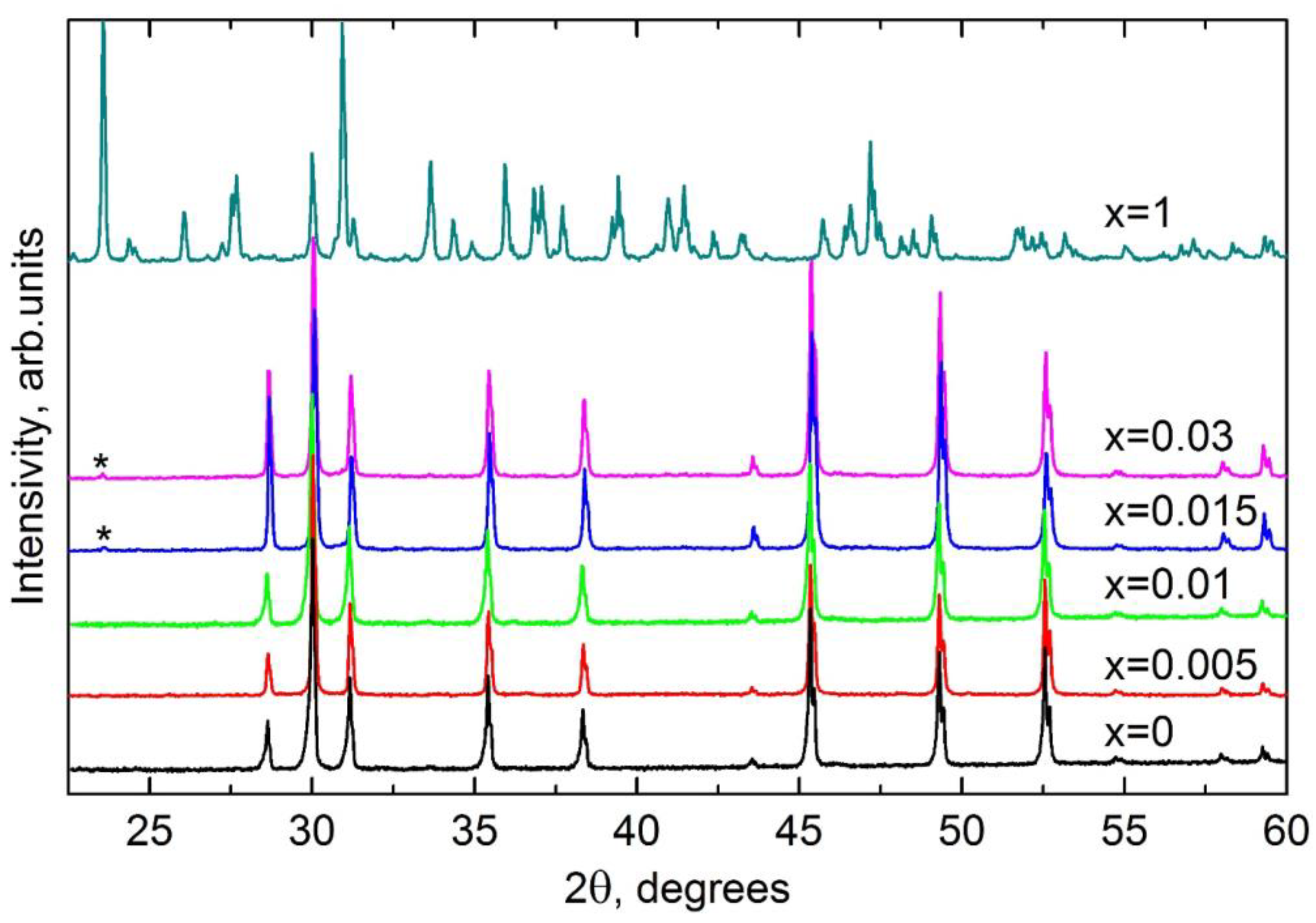
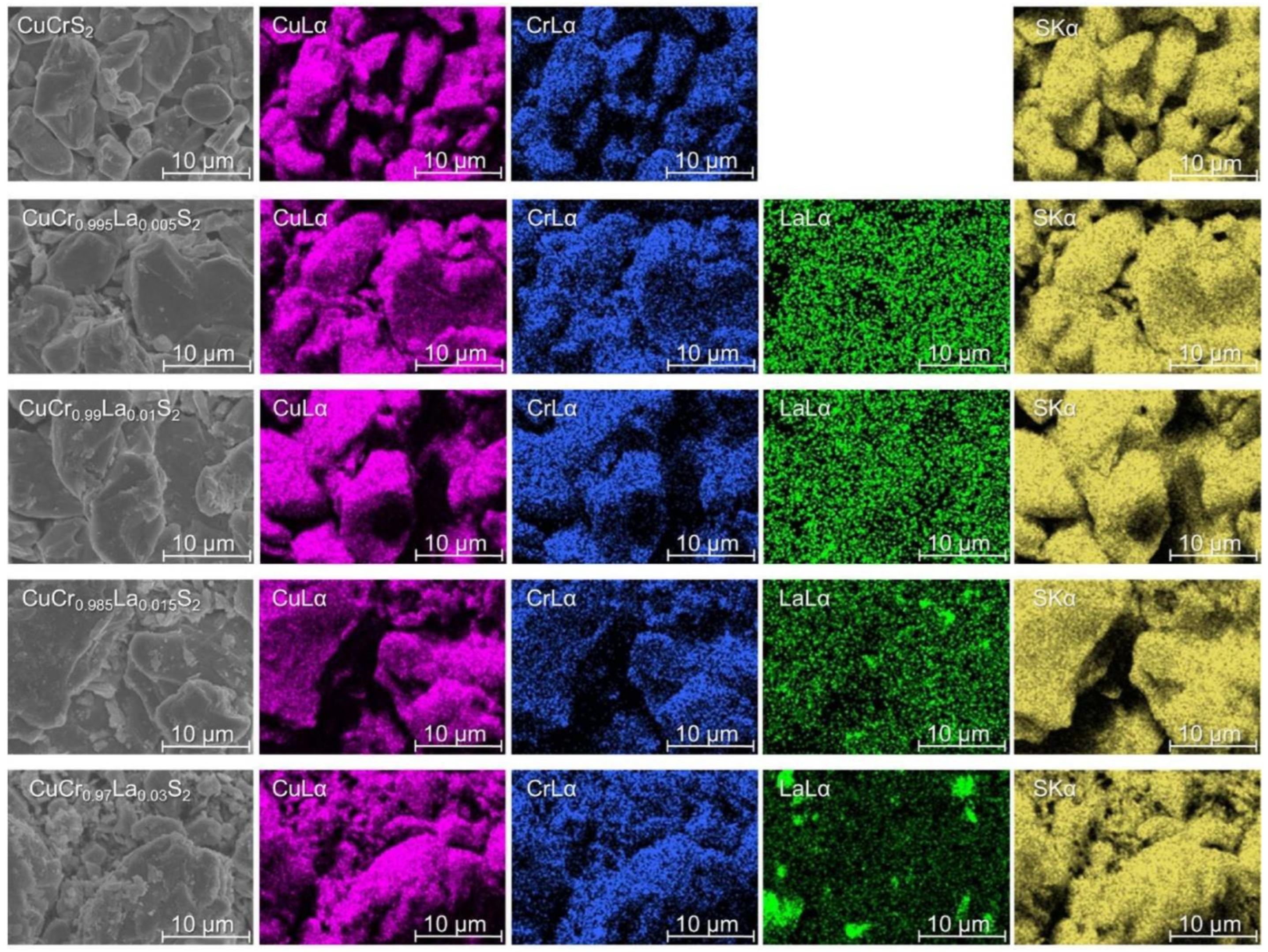
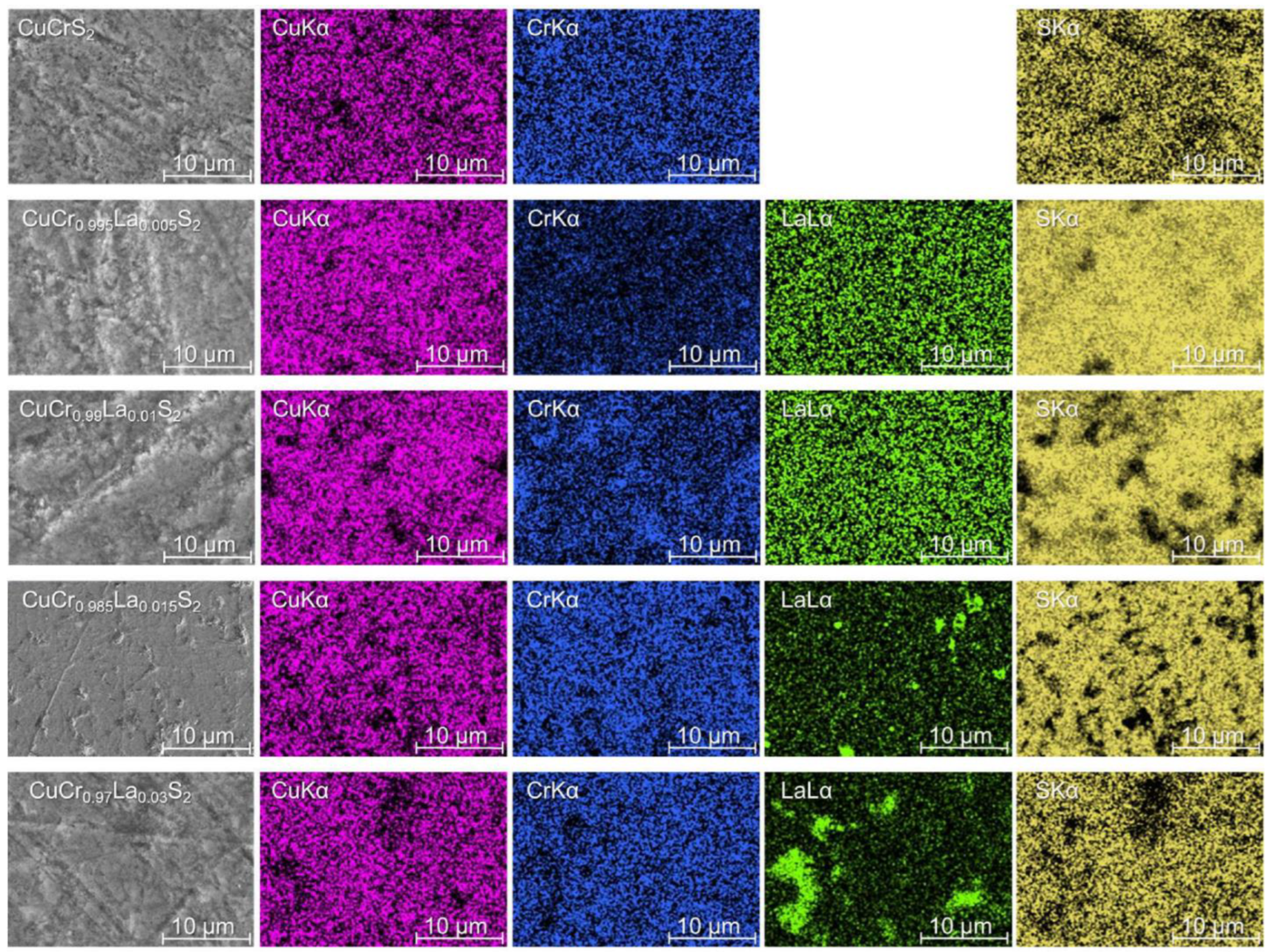

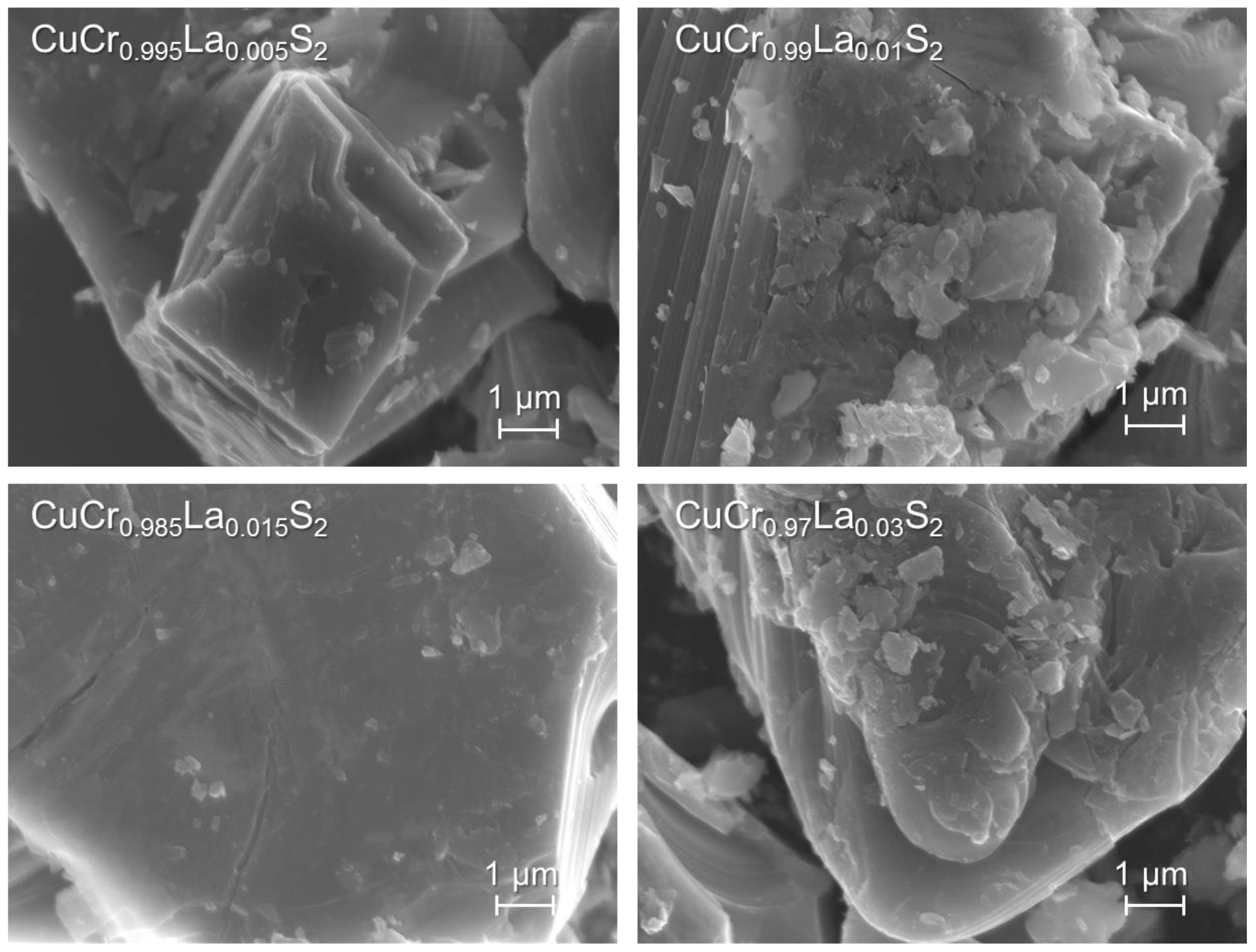


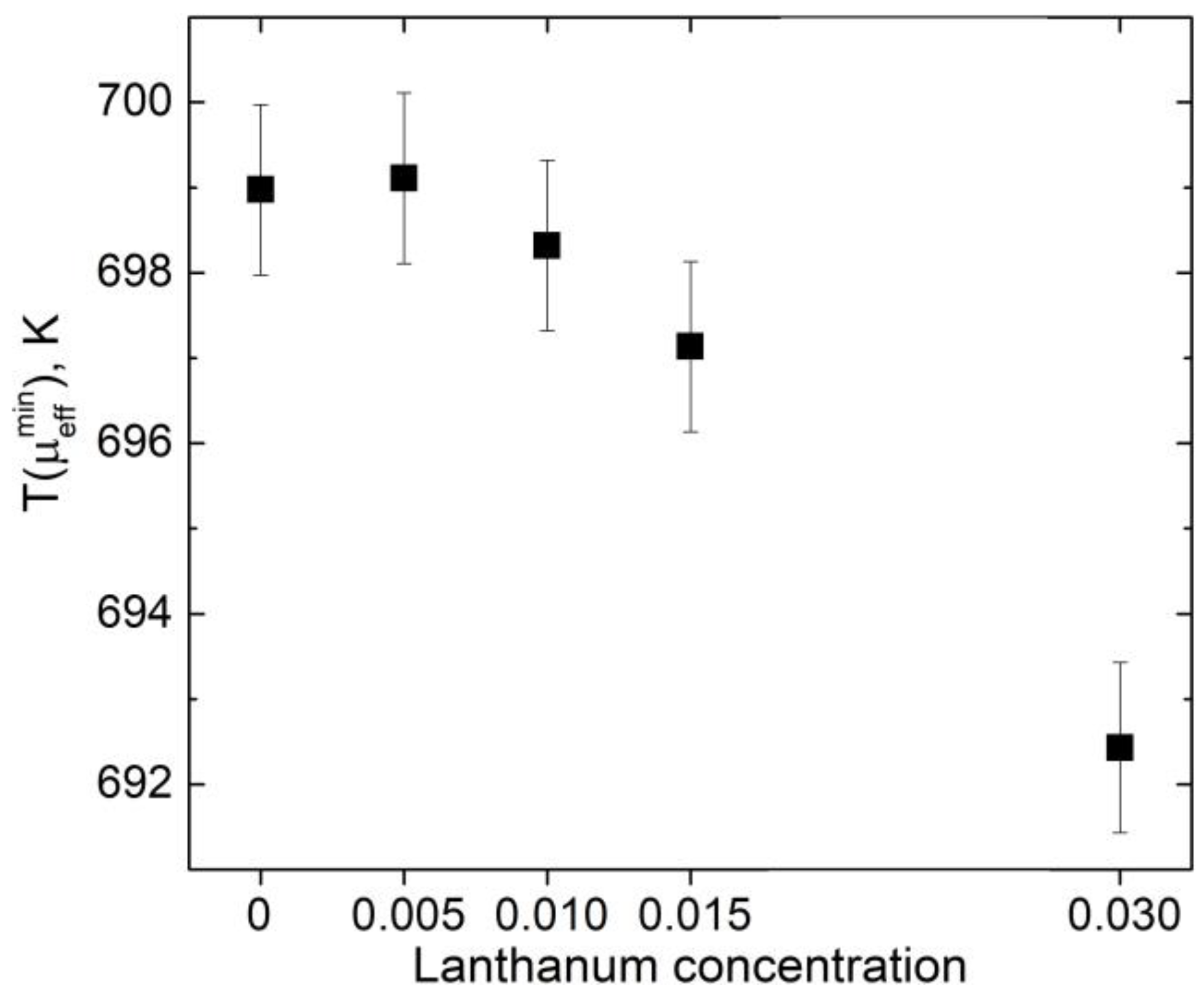

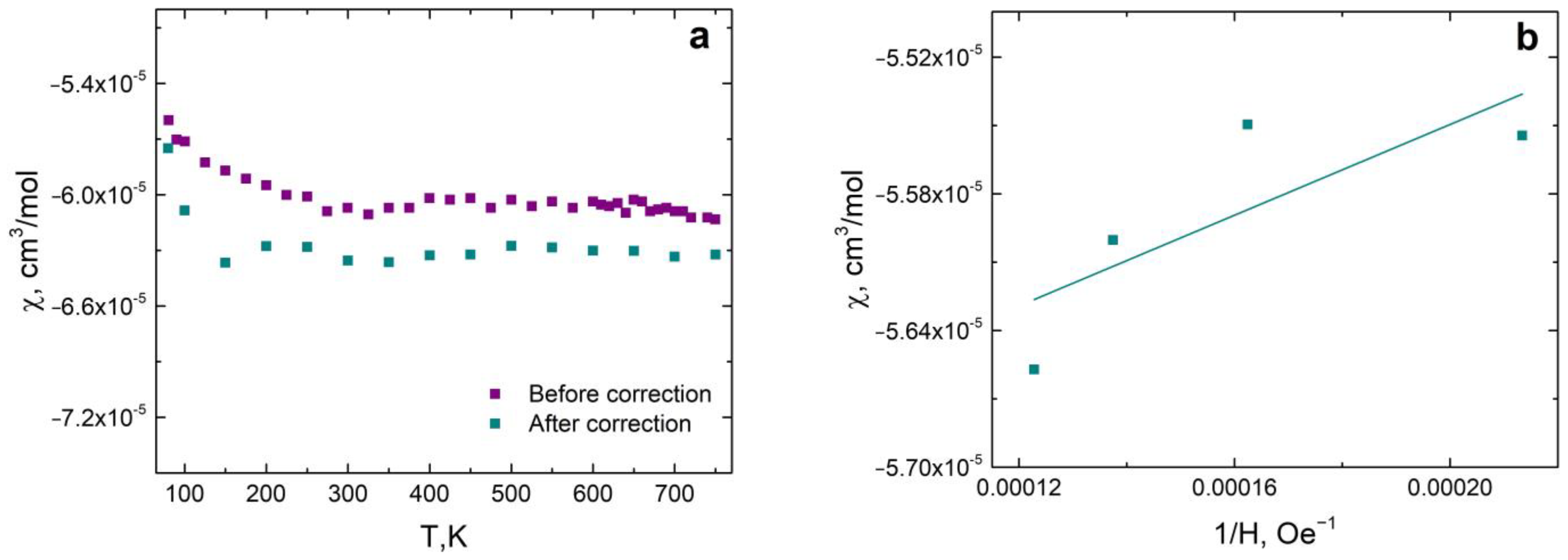
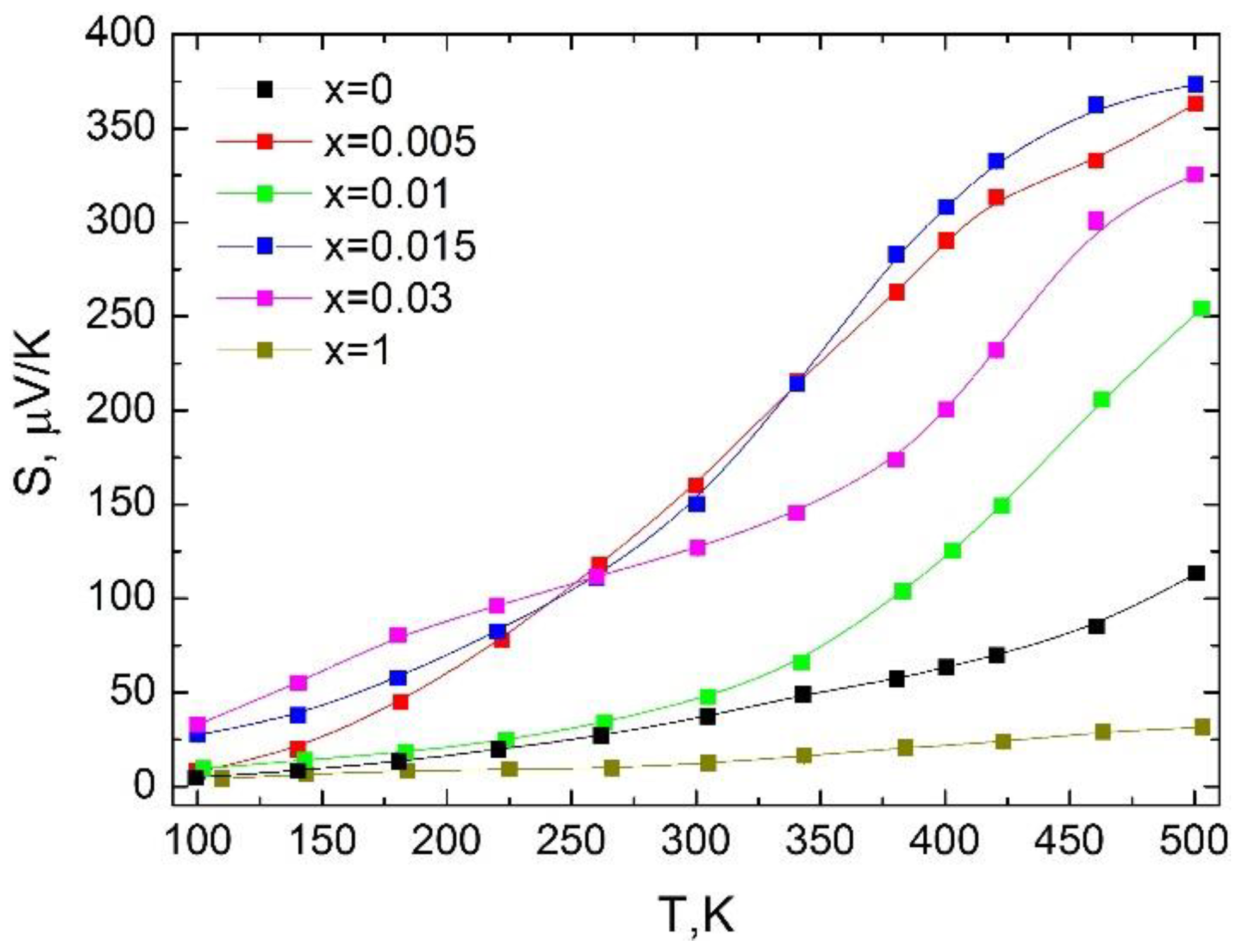

| Sample | a, Å | c, Å |
|---|---|---|
| CuCrS2 | 3.482(7) | 18.701(5) |
| CuCr0.995La0.005S2 | 3.482(9) | 18.706(6) |
| CuCr0.99La0.01S2 | 3.483(6) | 18.716(4) |
| CuCr0.985La0.015S2 | 3.479(1) | 18.686(8) |
| CuCr0.97La0.03S2 | 3.480(1) | 18.696(7) |
Disclaimer/Publisher’s Note: The statements, opinions and data contained in all publications are solely those of the individual author(s) and contributor(s) and not of MDPI and/or the editor(s). MDPI and/or the editor(s) disclaim responsibility for any injury to people or property resulting from any ideas, methods, instructions or products referred to in the content. |
© 2023 by the authors. Licensee MDPI, Basel, Switzerland. This article is an open access article distributed under the terms and conditions of the Creative Commons Attribution (CC BY) license (https://creativecommons.org/licenses/by/4.0/).
Share and Cite
Korotaev, E.V.; Syrokvashin, M.M.; Sulyaeva, V.S.; Filatova, I.Y. Magnetic Properties of CuCr1−xLaxS2 Thermoelectric Materials. Magnetochemistry 2023, 9, 168. https://doi.org/10.3390/magnetochemistry9070168
Korotaev EV, Syrokvashin MM, Sulyaeva VS, Filatova IY. Magnetic Properties of CuCr1−xLaxS2 Thermoelectric Materials. Magnetochemistry. 2023; 9(7):168. https://doi.org/10.3390/magnetochemistry9070168
Chicago/Turabian StyleKorotaev, Evgeniy V., Mikhail M. Syrokvashin, Veronica S. Sulyaeva, and Irina Yu. Filatova. 2023. "Magnetic Properties of CuCr1−xLaxS2 Thermoelectric Materials" Magnetochemistry 9, no. 7: 168. https://doi.org/10.3390/magnetochemistry9070168
APA StyleKorotaev, E. V., Syrokvashin, M. M., Sulyaeva, V. S., & Filatova, I. Y. (2023). Magnetic Properties of CuCr1−xLaxS2 Thermoelectric Materials. Magnetochemistry, 9(7), 168. https://doi.org/10.3390/magnetochemistry9070168







